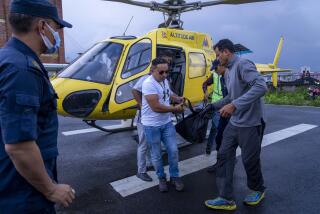Fatal Grand Canyon Flight Had Exemption From FAA
- Share via
To protect the solitude in the depths of the famed chasm that stretches across northern Arizona, much of the Grand Canyon is closed to air traffic. An exemption to the no-fly zones was created by the Federal Aviation Administration for the Hualapai tribe, which continues to allow tourists to soar up and down the canyon walls on its massive reservation.
A helicopter crash that killed seven Saturday was on such a flight.
Among the dead were foreign travelers and their Japanese pilot. Identities of the victims were withheld by officials until their relatives could be notified, said Det. Carlos Rooks of the Mohave County sheriff’s office in northwest Arizona. Recovery crews from the sheriff’s office and the Mohave County Search & Rescue Rope Team were walking to the crash site Sunday, he said, because it is the only way to reach the remote location 50 miles northeast of Kingman.
National Transportation Safety Board investigators were to fly over the crash site Sunday night and hike in today to begin an investigation, said spokesman Terry Williams.
The accident, which occurred at 12:55 p.m., killed all seven aboard the Aerospatiale helicopter, which was filled to capacity, according to FAA Western Pacific Region Operations Officer Larri Frelow.
The flight was operated by Sundance Helicopter, headquartered in Las Vegas. The sightseers and their pilot were headed to the Meadview, Ariz., helipad called Grand Canyon West near the river at the bottom of the canyon, Frelow said. The helipad, which is on the Hualapai reservation, has no air traffic controllers.
Sundance spokeswoman Marie Holmes said the company would issue a statement after families of the dead had been contacted.
The FAA restricted flights on Sunday, requiring operators seeking to land at Grand Canyon West to file a flight plan. Air traffic controllers will be reviewing flight requests on a case-by-case basis, Frelow said.
Among the dead were two Japanese tourists and two German tourists, Rooks said.
A Japanese news service identified two of the dead passengers as Akiko Hatano and Masami Kato, women from the Kanagawa Prefecture in Japan. The male pilot was a Japanese citizen who was a permanent legal resident of the United States, according to the Japanese Consulate in Los Angeles, Associated Press said.
It was the first fatal crash in the canyon since 1999, though six people were killed in a 2001 helicopter accident outside Meadview.
The FAA passed rules against commercial air tours over much of the Grand Canyon in 1996 and again in 2000. Restrictions were put on the number of flights tour operators could fly and the number of trips over the canyon they could take, while limiting flying to certain routes.
“It’s more restrictive to fly into the Grand Canyon than it is to LAX or JFK,” said Nigel Turner, president of Heli USA Airways, a helicopter tour operator based in Las Vegas.
The rules are intended to restore as much quiet to the national park as possible, according to FAA documents, but one of the beneficiaries of the rulings asked for an exemption. The Hualapai tribe opposed the limits, saying that a freeze on flights would cost the tribe millions of dollars in revenue.
The loss of landing fees and tourist spending would be “tantamount to shutting down a sovereign tribal nation,” the Hualapai told the FAA. The majority of the residents of the 1 million-acre reservation in the southwestern quadrant of the canyon live below the poverty line and depend on tourism. Without the income from air travelers, the tribe might consider bringing casinos to the south rim of the canyon, an FAA report said.
The FAA supported a waiver for the Hualapai in 2000 and exempted all flights to and from Grand Canyon West airport. An air tour operator contested the flight restrictions in a lawsuit against the FAA, saying that the rules unfairly favored the tribe.
The U.S. Court of Appeals for the District of Columbia sided with the agencies’ interpretation that they were authorized to create race-based exemptions for Native Americans. In April, the Supreme Court decided not to review an appeal.
Hualapai representatives could not be reached for comment Sunday.
Tour operator Turner described the accident as unfortunate, but added that thousands fly over the canyon safely every year.
More to Read
Sign up for Essential California
The most important California stories and recommendations in your inbox every morning.
You may occasionally receive promotional content from the Los Angeles Times.











